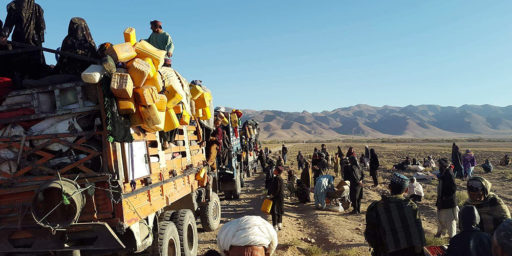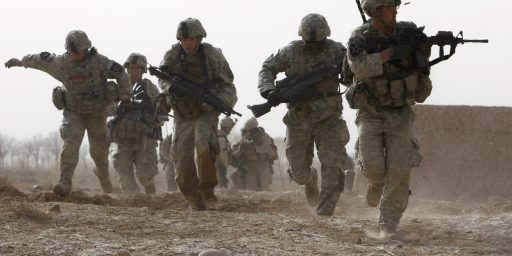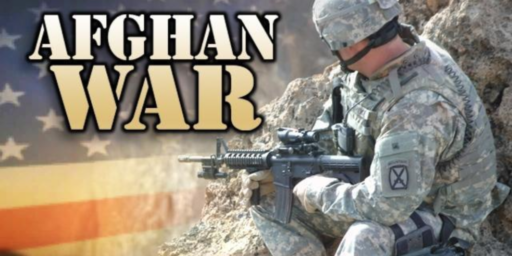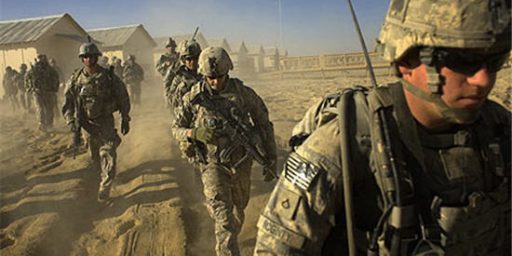U.S. Halts Public Progress Reports On The Never-Ending War In Afghanistan
The U.S. military will no longer release reports regarding the success, or failure, of the current strategy in Afghanistan.

The U.S. military will no longer report on how much territory is controlled by the Taliban in Afghanistan, making it much harder for Congress and members of the general public to assess whether the current strategy in that country is succeeding:
KABUL, Afghanistan — The American military command in Afghanistan has halted regular assessments of how many people and districts the government and insurgents there control, it emerged on Wednesday — eliminating what has long been an important public measure of progress in the war.
The military said the assessments had “limited decision-making value” for commanders. As recently as November 2017, the previous American commander in Afghanistan had called them “the metric that’s most telling in a counterinsurgency.”
The decision to end the assessments, which have been produced in various forms since at least 2010, was published in the latest quarterly report by the American special inspector general for Afghanistan reconstruction.
“We’re troubled by it,” the inspector general, John F. Sopko, said in an interview. “It’s like turning off the scoreboard at a football game and saying scoring a touchdown or field goal isn’t important.”
The military command in Afghanistan told the inspector general that the assessments, which had covered each of the country’s 407 districts, were “subjective” and were plagued by “uncertainty in the models” that produced them, the report said.
“We are focused on setting the conditions for a political settlement to safeguard our national interests,” Col. Dave Butler, a spokesman for the American-led military mission in Afghanistan, said in a statement to The New York Times. The assessments “did little to serve our mission of protecting our citizens and allies,” he said.
Colonel Butler added that the information in the assessments was already provided to Mr. Sopko by intelligence agencies.
Mr. Sopko said that while United States and Afghan forces, along with the Taliban, knew what was happening on the ground in Afghanistan, ending the assessments cut off vital public information. He said he and many members of Congress had access to classified information unavailable to the public.
“The only people who don’t know what’s going on and how good or bad a job we’re doing are the people paying for it — the American taxpayers,” he said.Bill Roggio, a military commentator whose assessments have challenged the Pentagon’s analyses, said the assessment reports had recently reflected a shrinking in the territory the government controlled, particularly outside urban areas.
“The district assessments highlight failure, which is contrary to the U.S. military’s desired message of success,” Mr. Roggio said in an email.
“Make no mistake, if these assessments showed the Afghan military retaking lost ground, the U.S. military would continue to publish the information.”
Mr. Sopko’s report said the assessments had limitations but were “the only unclassified metric” provided by the military “that consistently tracked changes to the security situation on the ground.”
It turns out that this is only part of the extent to which the military and Administration have sought to limit the information available to the oublic regarding the progress, or lack thereof, of a war that will enter its 19th year in October:
In October 2017, the military stopped reporting casualty figures for Afghan security forces at a time when casualties were approaching what the Pentagon now considers unsustainable levels.
Also classified or restricted are performance assessments for Afghan security forces and information about the operational readiness of Afghan Army and police equipment; anticorruption efforts by the Afghan Ministry of the Interior; and progress by the Afghan military on certain security-performance benchmarks.
Anthony H. Cordesman, a national security analyst at the Center for Strategic and International Studies, said ending the assessments “means there now is no official estimate of progress in the war since late 2018.”
But he added in an email, “There is no reliable way to know who is ‘winning’ or the level of ‘stalemate.'” That included the assessments, which he said had often seemed too positive.
It seems to me that there are only a few why the government would stop releasing one of the only public reports that have been regularly issued that give at least some indication of how the war is proceeding. More importantly, though, it leads to the conclusion that the Administration and the military are seeking to hide important information from the public about a war that now quite literally spans generations.
The primary reason for suppressing such reports, of course, would be to hide the fact that the American-backed government is losing ground to the Taliban and that the current counter-insurgency strategy is not succeeding. This is seemingly confirmed by the most recent such assessment. which was released in January and covered the period for the third quarter of 2018. That report indicated that the Afghan government controlled territory containing roughly 63.5% of the nation’s population. which was a decrease of 1.7 % from the previous quarter. While this seems like a small amount, it appears to continue a trend in which the Taliban were, slowly but surely, regaining a foothold in parts of the country from which they had previously been ousted.
The most recent American military assessment, released in January for the three-month quarter ending in October, showed that the government in Afghanistan controlled territory containing 63.5 percent of the country’s population. That represented a 1.7 percent decrease from the previous quarter. The report also stated that gains by the Taliban had given them control over territory containing roughly 10.8% of the population, with the remaining areas considered contested.
Other estimates about the state of the central government’s control over the country are far more pessimistic. For example, an analysis co-authored by Bill Roggio, who is quoted in the piece above, and published in the Long War Journal found that the Afghan government actually only had control over territory comprising 48% of the population, that the Taliban controlled territory covering roughly 9% of the population, and the rest being contested. Whichever analysis you believe, though, it seems clear from the numbers that the Taliban is not only holding on to the territory it has won back in the past but that it seems to be slowly regaining control in areas from which it had previously been eradicated. This would indicate that the current strategy in Afghanistan is not succeeding and, quite likely, is not going to succeed any time soon.
It’s also possible that the claims that the reports are being stopped is due to their unreliability. That argument, however, is undercut by past comments from Pentagon officials and commanders on the ground who have referred to these assessments as one of the most important measures in determining the success of the ongoing war effort. For example, General John Nicholson Jr., who served as the American commander on the ground in Afghanistan until September 2018 was quoted by reporters in 2017 as referring to the information contained in these reports as “the key factor that we’re looking at” in determining the success of the current strategy. At the time Nicholson also said that he hoped that there would be sufficient progress in the war effort such that the government in Kabul would control territory containing at least 80% of the population by the end of this year. Given the most recent data, that seems unlikely.
As several people quoted in the report above said, the only thing that ending these reports accomplish is to deny members of the public and lawmakers who do not have clearance to receive classified information on the progress of the war the information they need to assess the success of the war effort. To say that this is utterly unacceptable is to put it mildly and is not qualitatively different from a decision to not release casualty or other reports regarding the war.
We’ve been fighting this war for nearly 18 years now and we don’t seem any closer to the point where it can be said to be “over” than we were in the years immediately after the September 11th attacks. The difference, of course, is that the strategy regarding the war and the reasons we are there have shifted significantly over the past 18 years. What started out as a military operation to take out the plotters behind the September 11th attacks has morphed into an effort to keep a central government that seems unable to defend itself in power and put our thumb on the scale in what amounts to an Afghan civil war.
This is not what the American people signed up for, and the fact that the government is seeking to suppress information vital to determining whether there is any value in what we’re doing is outrageous. Afghanistan is of no real strategic value to the United States and our continued presence there serves no useful purpose other than to allow the troops to continue to be a target for Taliban and other forces fighting against the government in Kabul. There comes a time when we just have to tell the Afghans that we can’t do this anymore, that they are going to either have to either resolve their differences at the peace table, or continue fighting a civil war that, effectively, has been going on since the Soviet occupation in 1979, and there seems to be no better time than the present. We’ve done all we can in Afghanistan and more, it’s time to come home.






Pre-existing civil war, followed by a long period of US intervention, followed by continuation of civil war. Afghanistan or Vietnam? Trick question, the answer is: both.
Very different in Iraq and Libya where we knocked off one tyrant, preparing the way after a period of turmoil, for a new tyrant.
Then there’s Syria where. . . who the hell knows, really?
You know, I’m starting to think we don’t know WTF we’re doing, and we sure as hell don’t know how to do it.
@michael reynolds:
“You know, I’m starting to think we don’t know WTF we’re doing, and we sure as hell don’t know how to do it.”
All the more reason for us to get involved in Venezuela, right?
I remember Nixon’s “secret” bombing of Cambodia. Cambodia certainly knew. North Vietnam knew. The South Vietnamese probably knew. The target of secrecy was Congress and the public.
That’s the ticket. Public progress reports don’t show enough progress? Stop issuing public progress reports! Problem solved.
A boy, born when this war started, must go register with the Selective Service.
@Moosebreath: But things will be different in Venezuela because Venezuela is different from Afghanistan in many of the same ways that Afghanistan was different from Vietnam. You can’t compare them–the experts can explain it to you.
I guess that we should start standing by for the last scene–where the helicopters take the last of the employees off the roof of the embassy in
SaigonKabul, leaving the locals to the tender mercies of the graciouswinnersfirst place finishers.Now, onward! Caracas awaits!
@Just nutha ignint cracker:
Why is it that “the experts” never learn and integrate the fundamentals:
– War is hell
– No battle plan survives first contact with the enemy
– Only fight when you have to
We’re perpetually in the state of being a week before the Somme Offensive. Our planners are convinced that this time will be the successful push.
What, exactly, are our goals in Afghanistan? I suspect it’s just sunk-cost fallacy.
Yep!
The time, money and lives wasted boggle the mind.